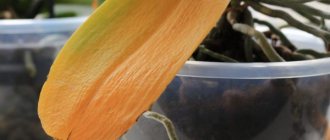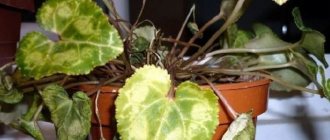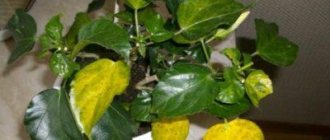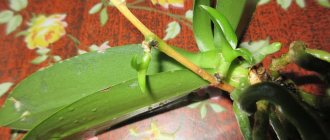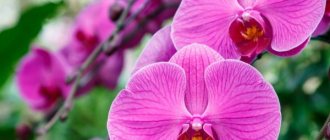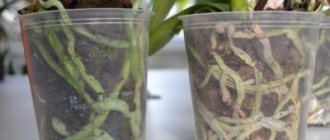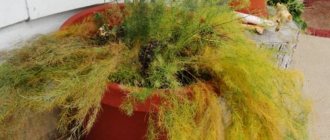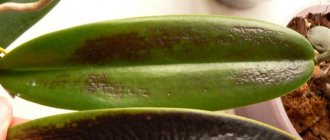Over time, yellowness may appear , which indicates ailments or physiological processes taking place in the plant cells.
If you do not pay attention and do not take appropriate measures in time, the diseased plant may die.
The immediate cause of yellowing foliage always
lies in a decrease in the synthesis of chlorophyll , the green pigment that determines the characteristic color. This can happen under the influence of various factors - from improper care to various diseases. In this case, yellowing can affect not only the stem, but:
- Roots;
- Leaves;
- Peduncle.
In this article you will learn why an orchid's stem turns yellow and what to do in such a situation.
What is yellowing?
It happens that orchids turn yellow. This occurs due to various factors affecting the life processes of the plant. As a result, the pigments responsible for the green color are formed in small quantities, and part of the flower changes color. Yellowing affects not only the stem, but the roots, leaves, and peduncle.
Yellowness can appear in one part of the plant, and subsequently affect all organs of the plant.
The appearance of a yellow color indicates ailments or physiological processes.
Read more about why an orchid turns yellow here.
Natural causes
For phalaenopsis, the annual loss of one of the lowest leaves is the norm. This is a natural process associated with the life cycle. It begins with yellowing of the leaf blade, which gradually becomes bright yellow, then wrinkles, turns brown and falls off.
Even such an easy-to-care orchid as phalaenopsis can get sick at home. This flower is rarely susceptible to fungal and bacterial diseases. In most cases, phalaenopsis leaves turn yellow and wither. This is the result of improper care. Why does this happen and what to do when the leaves of the phalaenopsis orchid turn yellow and wither? Only experienced flower growers will explain the cause of the disease and offer effective treatment. Their experience in dealing with orchid ailments is offered below.
Consequences for the plant
It’s bad if the stem turns yellow on a young plant, then the cause of aging disappears by itself. The main danger is not to delay treatment , but to react to the first symptoms at the same time. Provide timely assistance to a diseased plant, as the consequences are fraught with:
- complete yellowness and falling off of all leaves;
- drying out of the peduncle;
- deterioration of general condition due to infectious diseases;
- disturbance in the development of the root system;
- cessation of flowering.
Orchid diseases
Diseases of orchids are considered a common cause of yellow leaves, and at home, the crop is mainly affected by fungi.
In this case, the leaves of the plant become covered with yellow spots. To cope with the problem, you need to carefully remove the affected parts, and spray the crop itself with any fungicide. But even after such treatment, certain measures should be taken to prevent the fungus from returning. First of all, you need to inspect the flower for pests and review the watering schedule, since a common cause of fungal diseases is excess moisture.
From the video you will learn even more useful information about the causes of yellowing leaves in orchids and ways to combat this problem.
Why does the trunk turn yellow?
Indoor orchids are somewhat capricious plants. They can react negatively to even minor changes in parameters during cultivation. This is reflected in the appearance of the beauties. Therefore, determining the cause of yellow leaves or stems is not always easy, but it is still important. The main factors of yellowness:
- Sunburn. Bright light is, of course, good.
But everything is fine, it should be in moderation. Direct rays of the sun upon direct contact cause burns on leaves, stems, and flowers. A plant that is not accustomed to intense light does not tolerate it well. Problems also arise with artificial lighting. Incorrectly selected equipment can cause thermal damage. For these purposes, it is better to use phyto lamps that do not harm the plant and do not dry out the air. However, keep the distance between the lamp and the flower at least 20 cm. - Mechanical damage. A yellow color on the trunk may appear as a result of a fall or injury to part of the plant. The damaged part was not treated with an antiseptic in time, and as a result, wounds appeared on the stem, with possible rotting.
- Lack of moisture. A lack of fluid can occur in the complete absence of watering. The plant vitally needs a minimum volume of water, which dissolves the nutrients in the soil and nourishes the root system. Symptoms of this cause are:
- yellow leaf tips;
- yellow stem;
- light roots;
- the plant loses its elasticity.
- Lack of light. Orchids are shade-tolerant plants, but they certainly need sunlight.
This is especially acute during the period of flowering and growth. When a flower needs 14 hours of daylight. As a result of lack of lighting, leaves, aerial roots, and completely unformed buds dry out. In the absence of light, the process of photosynthesis slows down.
Excess moisture. Due to non-compliance with the correct watering regime, many ailments arise.
In plants that are at rest, vital processes are suspended; they do not need fertilizing with mineral fertilizers or frequent watering. At this moment, the flower does not absorb the same amount of moisture as, for example, in the growth phase, so the excess accumulates and causes yellowing, rotting, and wilting.- Fungal and bacterial infections. Violation of indoor microclimate parameters leads to the development of infectious diseases.
This is also possible if the quarantine regime is not observed. Attention! If fungal and bacterial infections are detected, the diseased flower should be urgently isolated from healthy ones, because the infection spreads very quickly.
Trimming
A faded orchid must be pruned according to the rules so as not to destroy the plant.
When is it time to prune an orchid?
The time from the beginning of October to November inclusive is considered the best period for carrying out this procedure, and it is suitable for almost any type of this wonderful plant. But exotic species (artificial hybrids) are pruned only in the spring, from the first days of March until the end of the month. The name of the flower indicates whether it is a hybrid or an original variety.
Therefore, when purchasing a phalaenopsis for yourself, be sure to pay attention to the name (or write it down) because its entire future life in the house will depend on it.
Using tools when pruning
Oddly enough, but metal scissors or simple garden pruning shears - pruning shears - are better suited for this.
Be sure to disinfect the instrument you decide to use with a solution of ordinary bleach. Try not to trim with a knife, because you can easily accidentally damage the leaves.
A faded orchid must be pruned according to the rules so as not to destroy the plant.
Pruning rules
First of all, carefully examine the flower, check for dormant buds from which children or new flowers can grow.
- In order for the phalaenopsis to bloom again, you need to count down three dormant buds and about 10–15 mm above the last one and cut off the peduncle there. Please note that this pruning method does not have a 100% guarantee that this flower stalk will produce buds or baby buds.
- In addition, if the peduncle is cut off from the top in this way, then there is still the possibility of a flower appearing, but a new stem is unlikely to grow, because the plant will use all its resources to support the old stem.
Cutting off the entire peduncle
A yellowed or completely shriveled stem must be cut off entirely, leaving only a small piece no larger than 20 mm in size. Do not spare the cut flower stalks, because soon the phalaenopsis will again delight you with its beautiful flowers.
Orchid after pruning
Caring for such a phalaenopsis is no different from usual. You just need to fertilize the plant with fertilizer to accelerate the growth of new leaves and the appearance of flowers. If the plant is resting after flowering, then you should not add fertilizers during this period.
Changing the color of the growth point
The top leaf of monopodial orchids is called the growing point. Its yellow color means a deviation from the norm; the plant has health problems. The reason for this phenomenon is uncomfortable conditions for keeping exotic plants and improper watering. Also a consequence of damage to the flower by infection. If this leaf is severely wounded, the orchid stops growing upward.
Many people believe that without a growing point, a plant cannot survive. It can, but the probability is not 100%. Finding itself without an active core, the exotic is susceptible to fungal diseases. If he has enough strength to overcome ailments, the plant will survive. The flower can produce a lateral shoot on the stem or peduncle, thus continuing to grow.
How to save if they lose turgor, turn yellow and fall off?
If the orchid leaves not only begin to turn yellow, but also fall off, then the plant must be urgently revived:
- Analyze the conditions of the flower and identify possible causes of the problem.
- Change the mode and methods of watering.
- Move the flower pot to another place.
- If the orchid is located next to yucca, peperomia, cordilina or ararkaria, then it is necessary to move them away.
- Replace soil and pot. A new pot must be disinfected with a solution of potassium permanganate before planting.
- Do not use fertilizers or growth stimulants for at least 14 days.
- If fungal or bacterial diseases are detected on the orchid, it must be treated with fungicides.
Important! Only soft water should be used for irrigation.
What to do to save the plant?
If the unexpected happened, the orchid trunk began to turn yellow, its natural state changed, and definitely some problems arose. No need to wait, respond urgently:
- Conduct a thorough visual inspection of the diseased plant.
- Find out what is causing this condition.
- Change the orchid's living parameters.
- Control the quality and frequency of watering. Water should not remain in the leaf axils.
If the measures described above did not produce any changes, we proceed to more radical ones:
Prepare pruning tools and disinfect them.- Remove any damaged tissue.
- Treat the cuts with ground cinnamon or crushed activated carbon.
If the leaves fall in addition to the yellow stem, perhaps this process is another symptom of rot or an infectious disease. In such cases it is necessary:
- treat the soil and plant with a 0.2% solution of Fundazol or Topsin;
- pour the drug directly into the wound of the plant;
- We carry out the procedure at least three times with an interval of 14 days;
- regularly inspect the diseased flower for signs of rotting;
- the buds on the peduncle can be treated with cytokinin hormonal paste to stimulate the appearance of children.
When is the process natural?
When an orchid from time to time one or two lower leaves turn yellow, while the remaining leaves are green. In this case, there is no reason to worry. Each leaf goes through its own life cycle. The old foliage dies off, and new shoots of the plant appear in its place. There is a natural change of leaves after 1-5 years, depending on the variety.
If the leaves die due to natural aging, then no therapeutic actions should be taken. The leaf blade will turn completely yellow and dry out, then it should be removed. The alarm should be sounded if young shoots begin to turn yellow or if a massive shedding of leaves occurs.
If the leaf has turned yellow, there is no need to tear it off or cut it off yourself.
Prevention
During the first time after amputation, be sure to adhere to the following recommendations.
- The first thing is to remove it from the southern window sill or shade the light with a tulle curtain. In autumn and winter, provide artificial lighting. The duration of daylight hours should be 10-12 hours.
- Three times – maintaining a comfortable temperature in summer: +22-25ºС. Do not place under air conditioning or leave in a draft; the plant may become overcooled. In winter +16-18ºС. Do not place near heating radiators.
- Third, the difference in temperature differences should not exceed 5ºС. At temperatures above +25°C and high humidity, fungal infections develop, and at temperatures below +15ºC – bacterial infections.
- Use a household humidifier to maintain humidity within 50-60%.
- Provide regular ventilation.
- Moisten the flower once every 7-10 days; in between, the soil should dry completely.
- Carefully ensure that moisture does not remain on the leaves. After watering, remove stagnant water from the leaf axils.
- Avoid the use of mineral preparations for the first time after the procedure. In the future, use nitrogen fertilizers during active growth, potassium and phosphorus fertilizers during the flowering period.
So, we looked at what to do if the orchid’s trunk turns yellow. By following all these rules, you will create favorable conditions for active growth and bright flowering of the orchid. An exotic flower will have good immunity and is not afraid of anything. And in the future, you will generally forget about diseases and health problems.
Reason #5: disease or pest attack
Another common cause of local or global yellowing is the development of infectious processes or pest attacks:
| External signs | Cause | Fighting methods |
| The appearance of local yellowing, yellow and brown spots on the leaves, sticky discharge, cobwebs and other contaminants. Visually, a cluster of insects is observed in the axils, on the stem, root collar or on the inner sides of the leaves. | Pest infestation:
|
|
| The appearance of dark spots, foci of necrosis, surrounded by yellowed tissue. Loss of turgor, softening and wetting of leaves. Cracks, plaques on leaves. Yellowing and blackening of the trunk. | Development of infections:
|
|
In all cases of disease damage, yellowed leaves will have to be removed. Sometimes this must be done after damage to leaf blades by pests, since areas of damage can become gateways for infection.
Prevention is necessary to prevent diseases and pest attacks. In the case of orchids, the main preventive measures are ensuring normal levels of air and substrate humidity, good aeration and lighting, the correct substrate and moderate fertilizing with potassium-containing fertilizers.
Treatment
- If the problem of drying is due to improper care of the plant, it is necessary to establish appropriate conditions for complete comfort.
- In case of overheating in the sun, it is necessary to move the pot with the plant to a cool, dark room. The isolation time should not exceed four hours. After time, the bowl with the orchid must be exposed to light, but not in direct sunlight.
- The flower dries out and shakes in the pot at the slightest touch - this is a symptom of a banal lack of moisture. To eliminate this problem, place the bowl with the plant in a bowl of warm water for one hour.
- There are cases of mechanical damage to the roots. In this case, it is very difficult to restore the health of the flower. This requires complete root system therapy:
- Carefully remove the flower from the pot.
- Inspect the root system for rotting and drying.
- Removing the affected areas with a sharp object.
- Treat a fresh cut with crushed activated carbon, cinnamon or wood ash.
- Change the substrate in the bowl and place the orchid there.
You can't get too carried away with fertilizers and mineral additives . This can have a bad effect on the leaves and stem of the plant. If this rule is neglected, you must carefully rinse all the roots of the flower under running water and inspect them for damage.
Below is a visual video about orchid treatment:
Reason #4: Overwatering or underwatering
Overwatering is the most common cause of yellowing of orchids. Moreover, yellowness on the leaves is the final stage, which can appear a month or two after the complete death of the roots.
Excessive watering is much more dangerous for epiphytes than lack of water. These plants are partly similar to succulents, since they are able to retain moisture for a long time and use it sparingly. In addition, their roots contain a special spongy tissue - velamen. Even in the complete absence of irrigation, it absorbs water from the air. Therefore, with chronic waterlogging, the following processes consistently develop:
- excess moisture in the substrate and velamen disrupts the circulation of oxygen and carbon dioxide in the root zone;
- velamen begins to rot;
- pathogenic microflora actively develops in rotting tissues and the surrounding substrate;
- the root system dies and root nutrition of the orchid stops;
- the flow of water, minerals and photosynthesis products from the roots to the leaves stops;
- leaves turn yellow and die.
If the reason for the yellowing of the orchid is waterlogging, there is nothing else left but complete pruning of the rotten roots and placing the plant in intensive care.
Drying out of orchids is much less common. Some experimental orchid growers conducted experiments that showed that orchids tolerate long two-month droughts quite calmly. Therefore, drying and death of the root system, resulting in yellowing of the leaves, develops only after a very long stay in a room with dry air without watering.
The method of combating yellowing due to the death of the orchid root system is pruning and stimulating the growth of new roots. Such problems can be avoided by normalizing watering.
Diseases and pests
Pests can be brought into a flower from a store or from the street. Main types of insects:
- Aphid. Collected on the back side of the sheet. Sucks out nutrients. It looks like a cluster of black or green dots.
- Shield. Dark growths on the back of the plates, larger than aphids.
- Spider mite. Small red insect. Leaves a small cobweb on the plant.
The orchid is also affected by infectious diseases. The most common problem is black rot. It occurs when a flower overflows. Signs: black spots on roots, stems, foliage, unpleasant odor, falling leaves. Another infection, but of fungal origin, is powdery mildew. Penetrating through the spores, it begins to feed on the orchid leaves, gradually destroying them. Signs: plaque, sour smell, lumpy leaf blades.
Video: Transplanting a phalaenopsis orchid into a large pot
If you have conscientiously eliminated all the reasons that caused the yellowing of the orchid leaves, but the flower has not recovered, this means that the plant has signs of a more serious disease, but they also look like ordinary yellowness.
Important! Fungal infections in the initial stage are very similar to them, but they will take a long time to treat; it may take more than one year until the plant is completely restored
Fungal diseases of orchids
The main diseases of orchids caused by fungi are various rots: gray, brown and black, root and fusarium. These are very dangerous diseases for the plant; if the plant is affected by them by 30 percent or more, then it will be impossible to save it. In case of small foci of infection, the bush can be revived using the most drastic measures.
- Immediately isolate the pot with the diseased plant from contact with other flowers.
- Remove the bush from the container, remove the substrate (dispose of it), and sterilize the container.
- Boil new pieces of wood bark in boiling water for 10-15 minutes, dry slightly, and cool.
- It is advisable to carry out all operations wearing sterile gloves.
- Clean the root system from the old substrate, soak in a solution of potassium permanganate or furatsilin for 30 minutes, shake off, and dry slightly.
- Trim the affected roots and leaves, treat the edges of the cuts with Bordeaux mixture, and sprinkle with charcoal powder.
- Place the plant treated in this way in a sterile pot with steamed (but dry) pine bark.
- Spray the top of the orchid with a fungicide solution (special for orchids), and carry out this treatment 2-3 times a week. Wipe accessible areas of damage daily with a damp cloth soaked in furatsilin.
- You cannot water the bushes for 3-4 weeks, then watering should be minimal. You can resume normal watering only when you see the first signs of improvement, that is, recovery of the flower.
